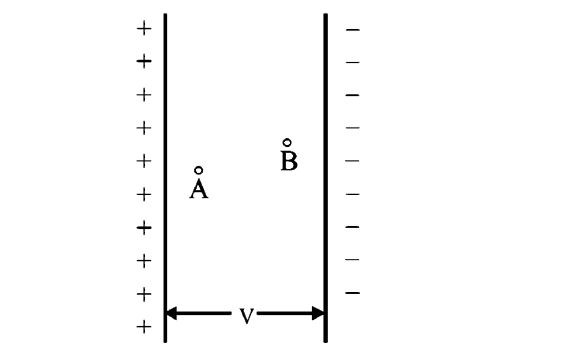Plates of a parallel plate capacitor, having a potential difference 100 V applied across them, carry a surface charge density of 50 nC cm−2. Spacing between the plates is
329μm
259μm
177μm
125μm
The correct Answer is:C
To find the spacing between the plates of a parallel plate capacitor, we can use the relationship between the surface charge density (σ), the potential difference (V), and the permittivity of free space (ε₀).
1. Identify Given Values:
- Potential difference (V) = 100 V
- Surface charge density (σ) = 50 nC/cm² = 50 × 10⁻⁹ C/cm²
2. Convert Surface Charge Density to SI Units:
- Since 1 cm² = 10⁻⁴ m², we convert σ to C/m²:
σ=50×10−9C/cm2×104cm2/m2=50×10−5C/m2=5.0×10−5C/m2
3. Use the Formula Relating Charge Density, Potential, and Plate Separation:
- The electric field (E) between the plates of a parallel plate capacitor is given by:
E=σε₀
where ε₀ (permittivity of free space) = 8.85 × 10⁻¹² C²/(N·m²).
4. Calculate the Electric Field (E):
E=5.0×10−58.85×10−12≈5.65×106N/C
5. Relate Electric Field to Potential Difference and Plate Separation:
- The relationship between electric field (E), potential difference (V), and distance (d) is:
E=Vd
Rearranging gives:
d=VE
6. Substitute the Values to Find d:
d=100V5.65×106N/C≈1.77×10−5m=177μm
Final Answer:
The spacing between the plates of the parallel plate capacitor is approximately 177 micrometers (μm).
- Potential difference (V) = 100 V
- Surface charge density (σ) = 50 nC/cm² = 50 × 10⁻⁹ C/cm²
- Since 1 cm² = 10⁻⁴ m², we convert σ to C/m²:
σ=50×10−9C/cm2×104cm2/m2=50×10−5C/m2=5.0×10−5C/m2
- The electric field (E) between the plates of a parallel plate capacitor is given by:
E=σε₀
where ε₀ (permittivity of free space) = 8.85 × 10⁻¹² C²/(N·m²).
E=5.0×10−58.85×10−12≈5.65×106N/C
- The relationship between electric field (E), potential difference (V), and distance (d) is:
E=Vd
Rearranging gives:
d=VE
d=100V5.65×106N/C≈1.77×10−5m=177μm
The spacing between the plates of the parallel plate capacitor is approximately 177 micrometers (μm).
Topper's Solved these Questions
Similar Questions
We have two metal plates of surface area 1m2 to construct an air parallel plate capacitor. A potential difference of 210 V is to be applied across the capacitor. The dielectric strength of air is 1 and electric field between the plates is 3×106V/m. What can be the minimum separation between two plates? If the capacitor is constructed accordingly then how much charge it will hold when connected across a 210 V supply?
View SolutionThe plates of a parallel plate capacitor are charged to a potential difference of 117 V and then connected across a resistor. The potential difference across the capacitor decreases exponentially with to time. After 1s the potential difference between the plates is 39 V, then after 2s from the start, the potential difference (in V) between the plates is
View Solution
Knowledge Check
- Question 1 - Select One
In a parallel plate capacitor, the distance between the plates is d and potential difference across the plate is V. Energy stored per unit volume between the plates of capacitor is
AQ22V2B12ε0V2d2C12V2ε0d2D12ε0V2d - Question 2 - Select One
In a parallel plate capacitor, the distance between the plates is d and potential difference across the plate is V. Energy stored per unit volume between the plates of capacitor is
AQ22V2B12ε0V2d2Cε20V2d2D12ε20V2d2 - Question 3 - Select One
A.P.D. of V volts is applied across the plates of a parallel plate capacitor having plate area A. if Q is the charge on its plates and K is the dielectric constant of the medium, between the plates, then the plate separation is given by
Ad=AKε0V/QBd=Kε0V/QCd=AKε0Q/VDd=Kε0Q/V
The plates of a parallel plate capacitor are charged to a potential difference of 117 V and then connected across a resistor. The potential difference across the capacitor decreases exponentially with to time. After 1s the potential difference between the plates is 39 V, then after 2s from the start, the potential difference (in V) between the plates is
View SolutionThe plates of a parallel-plate capacitor in vacuum are 5.00mm apart and 2.00m2 in area. A potential difference of 10,000V is applied across the capacitor. Compute
(a) the capacitance
(b) the charge on each plate, and
(c) the magnitude of the electric field in the space between them.View SolutionA potential difference of 250 Volt is applied across the plate of a capacitor of 10 pF. Calculate the charge on the plates of the capacitor.
View SolutionTwo protons A and B are placed in between the two plates of a parallel plate capacitor charged to a potential difference V as shown in the figure. The forces on the two protons are identical.
 View Solution
View SolutionThe plates of a parallel plate capacitor are, not exactly parallel. The surface charge density therefore :
View Solution

